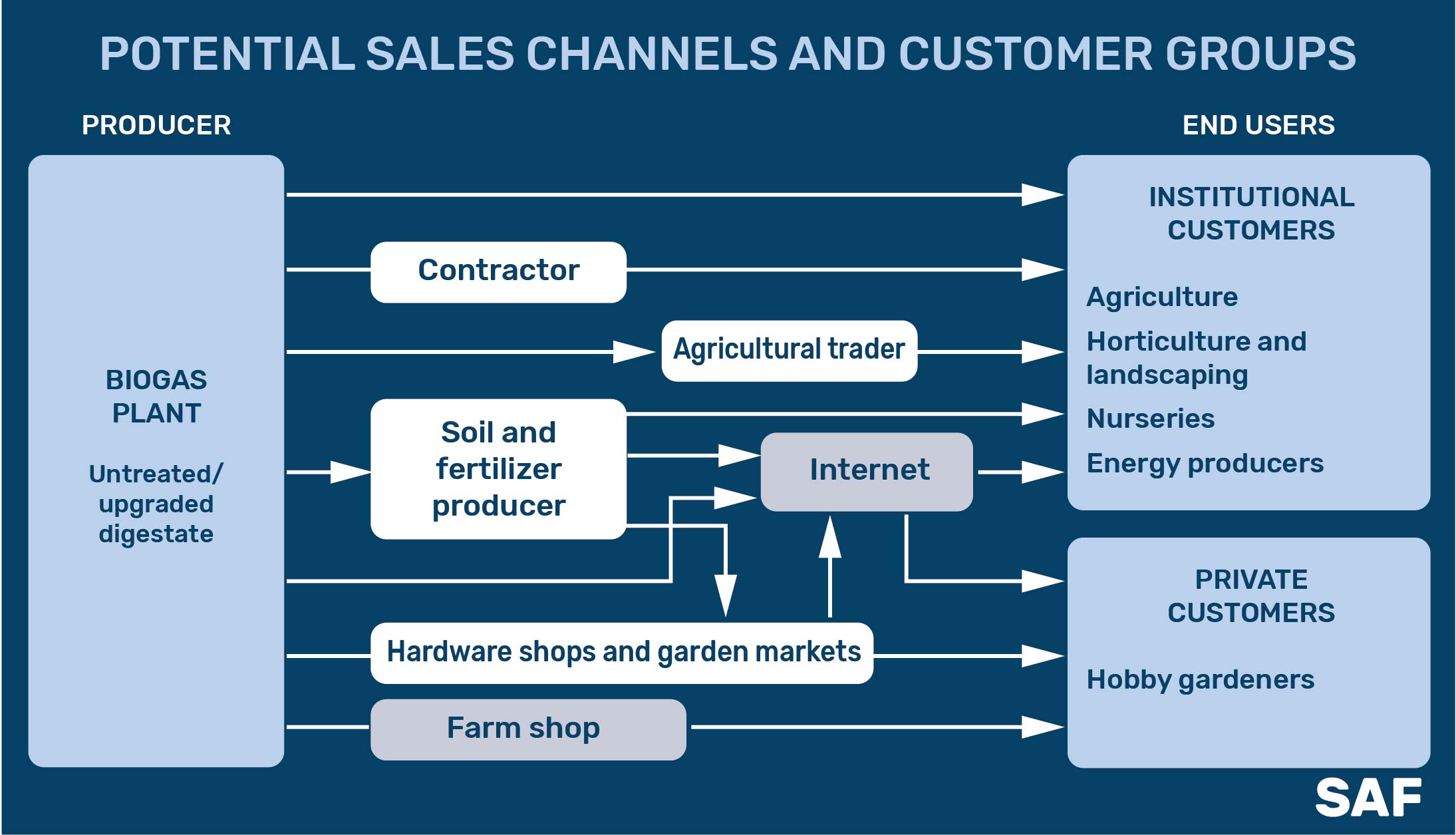Commercialization of the digestate involves the creation of a market product with appropriate characteristics and areas of application, which can be freely advertised, moved and sold.
Possible markets for the solid products can be divided into different sectors:
- agriculture (liquid and solid forms);
- horticulture – amateur (likely only solid form) and professional (liquid and solid forms);
- landscaping (exclusively soild form);
- forestry (likely only solid form);
- land reclamation (exclusively soild form).

Figure 1 – Potential sales channels and customer groups [1]
The current predominant digestate management practice in Ukraine is the introduction of liquid and solid fractions of digestate into the fields owned by the companies affiliated with biogas plant operators. This practice does not provide for commercialization. Given the compact location of the required area of land near the biogas plant, this practice is acceptable and, under certain conditions, economically feasible. The creation of market products from digestate will require further processing and the introduction of a quality management and control system throughout the whole value chain – from the source of raw materials for biogas production to end use.
Processing digestate facilitates marketing on three levels:
- Concentration of nutrients increases the value per unit of weight and thus decreases the transport costs;
- Stabilization and hygienization of digestate products, which makes subsequent handling more comfortable and safe;
- Upgrading, possibly coupled with the addition of nutrients and standardisation, taps into new sales markets (private gardeners) and new distribution channels (garden centres).
In this context, the involvement of specialized fertilizer companies in the processing and marketing of digestate products is a strategically promising way. Understanding by such companies of market needs in specific segments, pricing policy, development trends, can be the key to successful capitalization of the complex value of the digestate.
Qualitative indicators of digestate products are a determining factor in their commercialization, and therefore require careful attention. There are 3 main approaches to determining the quality of the digestate. The first approach, declarative, involves the presentation of actual, laboratory-confirmed characteristics of digestate products. This approach is partly used in the European voluntary certification scheme ECN-QAS for NPK complex content, dry matter, pH, sulfur content and electrical conductivity.
The second approach is restrictive and involves compliance with certain limits of minimum or maximum allowable content of individual components. This primarily applies to the content of heavy metals and pathogenic microflora. This approach is common to both the ECN-QAS certification scheme and the mandatory EU Regulation 2019/1009, which sets out the rules for placing fertilizers on the market, including digestate. At the same time, the Regulation also sets requirements for the minimum allowable content of nutrients and organic carbon for organic fertilizers and soil improvers, which would reffer to digestate as well.
Finally, the third approach is to standardize the quality of digestate products in certain ranges of values and with tolerances. In fact, this approach will create a product with high added value and target segments of demand, but at the same time it is the most complex and costly, and therefore the involvement of specialized companies is virtually unalterable.
All three approaches are potentially applicable in Ukraine and can be complementary. Necessary prerequisites for creating a market for digestate products can be:
- Introduction of the term “digestate” in the Ukrainian legislation, which would cover different types of raw materials, and providing an opportunity to place it on the market.
- Implementation of the scheme of voluntary certification of the digestate on the basis of the European scheme ECN-QAS.
- Establishment of state norms and requirements for the production, trade, use and advertising of organic fertilizers in general, and digestate in particular – adapting the requirements of Regulation (EU) 2019/1009 to the Law of Ukraine 86/95-VR of 13.02.2020 “On pesticides and agrochemicals” .
- Consideration of the possibility of supporting consumers of the digestate, subject to the actual replacement of mineral fertilizers (subsidy programs, tax benefits, etc.).
- Promotion of the digestate among potential consumer groups, in particular through a program of educational activities, including under the new EBRD and GEF program “Ukraine: Sustainable Innovation in the Value Chain in Bioenergy”.
[1] Digestate as fertilizer. German Biogas Association. Deutsche Gesellschaft für Internationale Zusammenarbeit (GIZ) GmbH. – November 2018.
Author: Petro Kucheruk – expert of Bioenergy Association of Ukraine
Read also:
Organic fertilizers in agriculture nutritions recycling
Consumption of organic fertilizers in Ukraine
The types of organic fertilizer produced in Ukraine and its market niches
Digestate post-treatment methods and derived products
Quality standardization and certification of digestate products